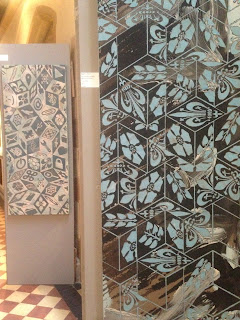Pugin's designs, inspiring Robert Dawson
 I was glad I'd made it. The church was built by Gothic Revival architect AWN Pugin, next door to his family home he also designed and built, up on the west cliff of Ramsgate. It was loved by Pugin and hugely embodies the spirit of all that was important to this Victorian genius. The building recently completed a new visitor and education centre, funded by the Heritage Lottery Fund, and I'm ashamed to say this is the first time I'd got inside to see the development. Really great to see, finally, a display and interpretation to honour Pugin and his relationship with Ramsgate. And it was enhanced by the work of Robert Dawson and his exhibition 'En Avant'.
I was glad I'd made it. The church was built by Gothic Revival architect AWN Pugin, next door to his family home he also designed and built, up on the west cliff of Ramsgate. It was loved by Pugin and hugely embodies the spirit of all that was important to this Victorian genius. The building recently completed a new visitor and education centre, funded by the Heritage Lottery Fund, and I'm ashamed to say this is the first time I'd got inside to see the development. Really great to see, finally, a display and interpretation to honour Pugin and his relationship with Ramsgate. And it was enhanced by the work of Robert Dawson and his exhibition 'En Avant'. Dawson works from his studio 'Aesthetic Sabotage' in London and specialises in using clay in developing pattern and print. His 21st century interpretations of some of Pugin's patterns give them a new life and I smiled at the panel on the far left of this picture, which puts the icons for Apple, the ethernet, 'power on' buttons and such like, alongside patterns familiar from encaustic tiles.
I was intrigued about how the panels were made, how the fine designs were actually accomplished using clay. Some had layers of cut paper or fabric as well, creating a series of textures, helping to bring the patterns to life. The panels definitely brought added interest to the spaces in the church and seeing the designs made you think about Pugin himself, and his work and obsessions with perfection in design of every aspect in the buildings he created - from the architecture to the items within them.
 I didn't know anything about Robert Dawson's work, but I'm interested now in finding out more. From his website it told me: Dawson began working with historic ceramic sources, which he manipulated and reapplied to china tableware and ceramic tiling. His re-workings of the Willow Pattern included the enlargement, distortion, and cropping of elements within this familiar chinoiserie decoration, and his new style of working has been widely imitated. Dawson soon moved on to the creation of large-scale public art works.
I didn't know anything about Robert Dawson's work, but I'm interested now in finding out more. From his website it told me: Dawson began working with historic ceramic sources, which he manipulated and reapplied to china tableware and ceramic tiling. His re-workings of the Willow Pattern included the enlargement, distortion, and cropping of elements within this familiar chinoiserie decoration, and his new style of working has been widely imitated. Dawson soon moved on to the creation of large-scale public art works.I can see why he was a perfect artist to link with the new centre and Pugin's church. "Dawson embodies the artisanal spirit of Pugin himself, while revitalising his designs for the twenty-first century." - seems to be pretty true!
References:
https://www.aestheticsabotage.com/en-avant
http://www.ramsgateandminster.com/shrine-of-st-augustine/


Comments
Post a Comment